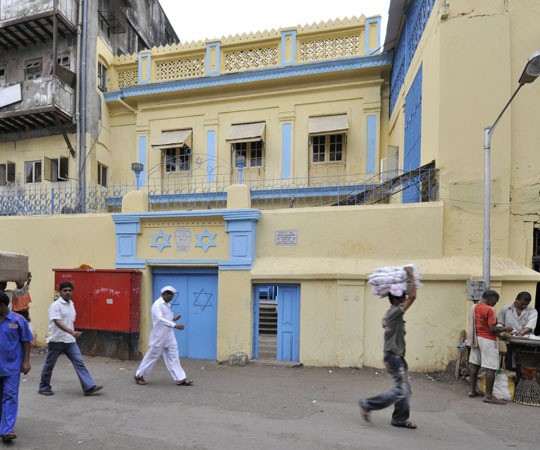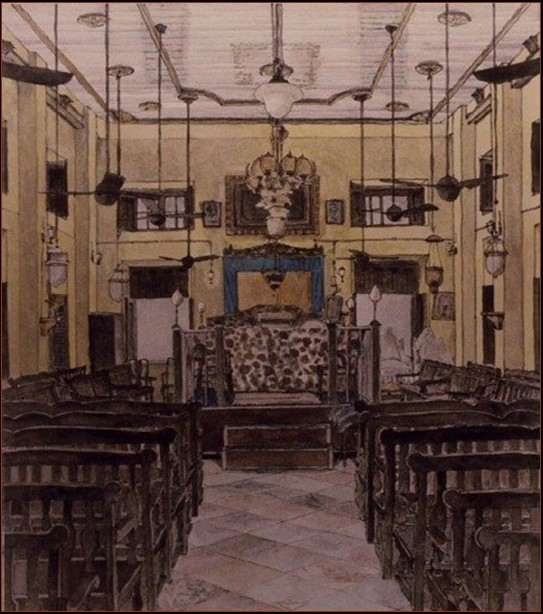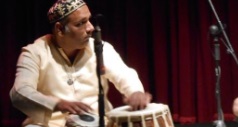SHAAR HARAHAMIM SYNAGOGUE (original building 1796; rebuilt 1860)
254, Samuel Street (also known as Israel Mohalla)
Mandvi
Mumbai
Maharashtra, INDIA
This synagogue remains open with a small yet active congregation, and visiting it is possible. A caretaker is sometimes there to immediately receive guests, yet a contact for an arranged visit is Samuel Waskar at This email address is being protected from spambots. You need JavaScript enabled to view it.. Note that the Mumbai police are stationed at the synagogue at all times to guard the property, but they cannot provide access to the inside. Another Bene Israel synagogue, Shaar Rason, is located very nearby within easy walking distance.
For their first forty years in Mumbai, the Bene Israel (Children of Israel) Jews managed by conducting prayer services in private homes or borrowed facilities. By the closing years of the eighteenth century, the growing and more organized community needed a proper synagogue not only for its physical space, but also as a spiritual, educational, and social center for Jewish life. This became a reality in 1796 when the first Bene Israel synagogue in India was built on this site. It was made possible through the efforts of the retired Jewish military officer Samuel Ezekiel Diveker of the Bombay Army following his heroic service during the Second Mysore War in 1783. According to oral history, Commandant Diveker and his men of the sixth battalion were captured by Tipu Sultan’s troops. While under seize, Diveker made a personal vow that, upon his and his men’s safe release, he would return to Mumbai and plan and fund the building of the first Bene Israel synagogue. This also included the procurement of a Torah. Diveker indeed survived as a result of Tipu Sultan’s mother intervention who viewed the Jews as God’s chosen people, and he returned to Mumbai to realize his dream. In his honor, the synagogue, erected at 245, Samuel Street near where a large Bene Israel community lived at that time, was named Samaji Hasiji, or Samuel’s Synagogue.
By the late 1850s, the synagogue’s membership had grown, and a larger building was needed. The original synagogue was demolished and a new one built on the same site The new building was consecrated on the 24th of March 1860. Its cost was met from congregational funds and from contributions from the managing committee. In 1896, for its centennial celebration, the synagogue was renamed Shaar Harahamim, Hebrew for Gate of Mercy.
Shaar Harahamim today remains an active synagogue in a bustling area of Mumbai. In the immediate neighborhood are residential and commercial buildings. A high wall and gate separate the synagogue from the crowded street. The Stars of David capping the wall were added in the early 1990s, and they along with an inscription mark this building as a synagogue site. The wall creates a small paved chowk, or courtyard, at the front of synagogue. Here this space has long served as an outdoor approach to the sanctuary and communal gathering spot for religious and social events. A narrow passage off the courtyard that loops around the building once led to a mikveh, or ritual bath.
Shaar Harahamim is a symmetrical, two-story structure finished in chunam, or plaster of polished lime and sand, which has been painted. The design is an eclectic blend of European and Indian elements. Most of the composition is Western in nature, such as the stylized Corinthian engaged pilasters separating the upper story windows and the cornice, yet the balustrade capping the synagogue is a derivation of the jali, or perforated screen common in some traditional Indian architecture. The pointed crenellations are another broadly Indian feature.
The courtyard fronts the synagogue proper, and here an exterior stair leads up to a caretaker’s apartment and to the women’s gallery within the sanctuary. A separate central set of steps leads into the covered porch, which is flanked by a synagogue office to the north and stairwell up to the women’s gallery. Off this foyer are doors opening into the sanctuary. The rectangular room, measuring 8 meters x 16 meters (26 feet x 52 feet), follows the spatial planning of other Bene Israel synagogues with its centrally-positioned tebah (bimah/reader’s platform where the Torah is read and the service conducted), freestanding wooden benches filling the room, and to the far wall the heckal (ark). Placed in the center of the western elevation that is closest to Jerusalem as per synagogue convention, the heckal here is an intricately-carved stained wooden cabinet that is draped in the traditional curtain called the parochet. The liturgically-important heckal, as per synagogue tradition, is elevated a few steps off the main floor level.
Shaar Harahamim sanctuary’s other design features include light gray marble floor pavers, large windows and transoms with louvered shutters along the painted chunam walls, engaged pilasters spaced around the walls, and a flat painted wood-stripped ceiling with decorative rosettes, corner medallions, and applied battens. Hanging from the ceiling, and providing a sense of place, are several ceiling fans, glass dome lanterns, and various-styled lighting fixtures. This includes the ner tamid in front of the heckal, or a special fixture that always burns to recall the presence of God. Other architectural and liturgical design features include framed Hebrew prayer verses along the walls, wall sconces, and a matching pair of draped chairs, flanking the heckal, one for the prophet Elijah and the other for the brit mila, or circumcision ritual.
For its bicentennial celebration in 1996, the synagogue was renovated in time for a gala event that was attended by the congregation and invited speakers and guests. The event planning committee also arranged with the government of India for a commemorative postage stamp to be issued to honor the momentous occasion. Shaar Harahamim continues to serve a small yet active congregation where prayer services are still held and visitors are made to feel welcome. The heritage building is testament to Mumbai’s proud tradition of tolerance and diversity.

Exterior

Interior








